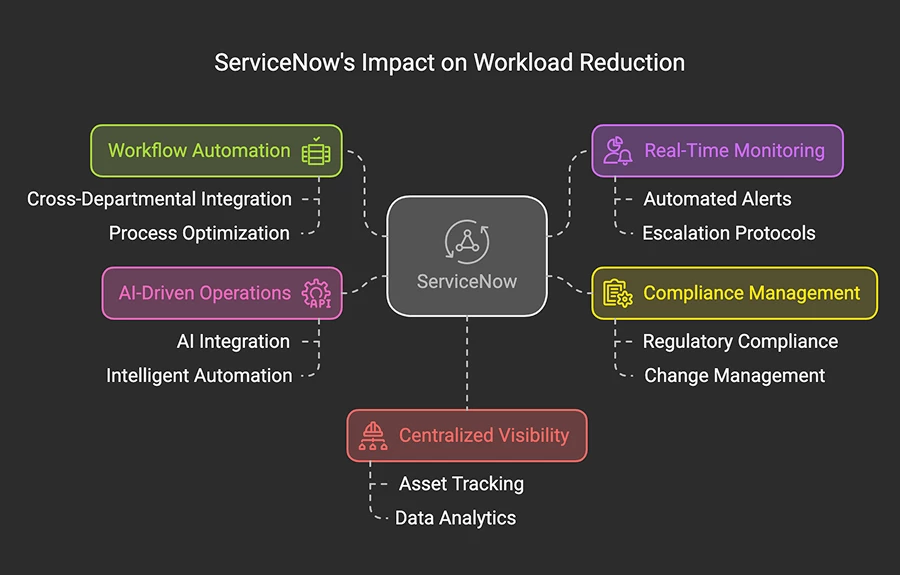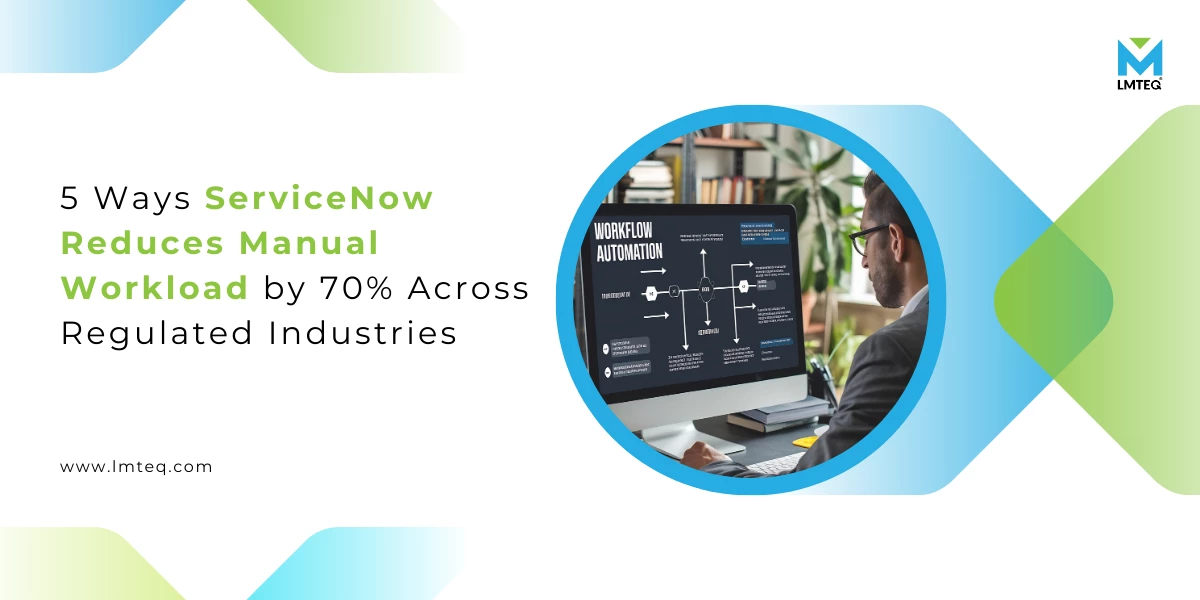Introduction – Why Manual Work Is Draining Regulated Industries — and How ServiceNow Fixes It.
If you’re leading operations in healthcare, BFSI, or manufacturing, chances are your teams are overwhelmed by one thing: manual work. From chasing approvals to updating audit logs, critical business functions are still tangled in outdated, time-consuming processes, despite digital transformation being the buzzword of the decade.
This isn’t just a minor inefficiency. It’s a risk. For industries bound by strict regulations — like HIPAA, SOX, IRDAI, or CDSCO — even a missed update or delayed ticket can snowball into non-compliance, revenue loss, or worse.
That’s where ServiceNow Automation steps in.
With its powerful suite of tools — including ServiceNow Process Automation, ServiceNow Intelligent Automation, and ServiceNow Service Automation — enterprises can reduce manual workload by as much as 70%. The result? Faster operations, real-time compliance, and more time for your teams to focus on what truly matters.
In this blog, we’ll walk through real-world scenarios from the US and India to show how regulated businesses are using ServiceNow to cut down manual effort, stay audit-ready, and scale with confidence.
What’s Broken — Real Operational Pain Points in Regulated Industries
Even with all the tools available today, most regulated organizations are still wrestling with broken processes, fragmented systems, and growing compliance fatigue. Here’s a closer look at what’s going wrong across sectors — and why simply “working harder” is no longer a sustainable option.
Healthcare (US & India) – Compliance Overload, Zero Visibility
Hospitals, labs, and diagnostics centers are under constant pressure to meet regulatory demands, be it HIPAA in the US or CDSCO/NABH in India. But compliance doesn’t just mean storing documents. It means actively managing licenses, updating records in real-time, and ensuring every machine, from MRIs to ECGs, is traceable and maintained.
The problem? Most facilities are still managing this with emails, spreadsheets, or siloed software. That means license expirations are missed, devices go untracked, and audits become a scramble.
With ServiceNow Asset Management, healthcare providers get full visibility into the lifecycle of every physical and digital asset. From automated maintenance alerts to centralized license records, teams can finally get ahead of audits instead of dreading them.
BFSI – Mounting Documentation, Missed SLAs, and Change Chaos
Banks and insurance firms operate in a high-stakes environment where every missed update can cost millions. Between RBI, IRDAI, SEBI, and global compliance standards like SOX and FINRA, it’s a nonstop flow of policy changes, documentation, and service requests.
Yet the reality on the ground is bleak:
- Tickets are manually triaged, often lost in backlogs.
- Regulatory updates are buried in inboxes.
- Audit logs are scattered across teams.
The ServiceNow Ticketing System changes that by streamlining issue resolution – automatically routing tickets based on priority, SLA, and historical context. When combined with ServiceNow’s regulatory change management, BFSI organizations gain a dynamic system that flags changes, updates workflows, and maintains a clean audit trail without manual effort.
Manufacturing – Siloed Plants, Unreliable Workflows, and Downtime
For manufacturers, the pressure to maintain product quality while complying with safety standards is relentless. Whether you’re adhering to US OSHA guidelines or India’s BIS standards, any gap in reporting, maintenance logs, or operator approvals can delay production – or worse, halt it altogether.
And in multi-plant operations, disconnected systems mean a local failure can go unnoticed until it becomes a supply chain bottleneck.
This is where ServiceNow Event Management proves its worth. By continuously monitoring systems and flagging anomalies, it helps prevent breakdowns before they impact output. Paired with ServiceNow Service Automation, manufacturers can trigger pre-approved workflows that ensure every action, from part replacement to inspection, is fully documented and compliant.
5 Ways ServiceNow Reduces Manual Workload by 70% for Various Industries

Organizations don’t just want automation — they want outcomes. Here’s how ServiceNow, through its intelligent platform capabilities, drives tangible operational improvements across healthcare, BFSI, and manufacturing in both the US and India.
1. End-to-End Workflow Automation Across Departments
Whether it’s onboarding new assets in healthcare, processing loan approvals in BFSI, or managing quality checks in manufacturing — manual workflows slow down everything. With ServiceNow Process Automation, repetitive, rule-based tasks are handled without human intervention.
What this means in action:
- A diagnostic center in Mumbai automates license renewal workflows for medical equipment.
- A US-based insurance firm uses workflow orchestration to fast-track claim escalations and reduce customer wait times.
By removing human bottlenecks, ServiceNow reduces errors, accelerates outcomes, and creates traceable digital records that make audits effortless.
2. Real-Time Monitoring with Automated Alerts and Escalations
In regulated industries, downtime isn’t just an inconvenience — it’s a liability. ServiceNow Event Management continuously monitors IT and operational systems, flagging anomalies and triggering alerts before issues escalate.
Use case:
A global manufacturing plant in Texas now receives proactive alerts for system lags that previously caused production halts. In India, a bank receives real-time alerts on failed KYC validation processes, allowing immediate intervention.
No more waiting for support tickets to get manually assigned. Escalations happen instantly, and issues are resolved before they impact compliance or customer satisfaction.
3. Unified Platform for Compliance and Regulatory Change Management
Regulatory updates don’t wait. And trying to track them via email chains or static checklists is a disaster waiting to happen.
ServiceNow regulatory change management enables dynamic, role-based workflows that track changes in real-time, map them to internal controls, and assign tasks to the right stakeholders.
Example:
A healthcare network in Chicago uses the platform to automatically adjust internal protocols when HIPAA updates are released. An Indian insurer integrates new IRDAI circulars into their risk workflow within hours — not weeks.
4. Smarter Service Operations with AI and Intelligent Automation
Time-consuming service desk operations are often a black hole for productivity. Using ServiceNow Intelligent Automation, teams can implement virtual agents, AI-based triage, and automated resolutions to repetitive tasks.
In practice:
- BFSI clients in the US reduce service desk load by 40% using AI bots that handle standard ticket types.
- A life sciences firm in Hyderabad uses predictive routing to direct complex compliance tickets to specialists, shaving hours off resolution time.
This isn’t just automation—it’s intelligence layered onto your operations.
5. Centralized Visibility and Asset Intelligence
Knowing what assets you have — and where they are in their lifecycle — is key to staying compliant. ServiceNow Asset Management gives a single source of truth for all enterprise assets, from medical equipment and factory machinery to IT hardware and software.
Use case:
A hospital in Delhi digitizes its asset inventory, tracks utilization, and sets auto-reminders for calibration and audits. A US manufacturing plant avoids fines by automatically scheduling inspections before certificates expire.
This level of visibility not only prevents regulatory breaches but also reduces unnecessary spending on duplicate or underutilized assets.
Real-World Success — How ServiceNow Drives Change on the Ground
Here’s how enterprises in highly regulated sectors are translating ServiceNow’s platform capabilities into real-world operational wins, with measurable outcomes and strategic advantages.
Case 1 – A Multi-Specialty Hospital in Bengaluru Cuts Audit Time by 60%
Challenge:
The hospital struggled to maintain centralized, up-to-date records of medical equipment licenses, resulting in last-minute audit prep and risk of non-compliance with CDSCO guidelines.
Solution:
Implemented ServiceNow Asset Management and ServiceNow regulatory change management to auto-track license renewals, maintenance schedules, and regulatory changes.
Result:
- Reduced audit prep time from 5 days to under 48 hours.
- Passed 3 consecutive NABH audits with zero non-conformities.
- Eliminated 90% of manual follow-ups between departments.
Case 2 – Tier-1 US Bank Resolves Tickets 50% Faster with AI Workflows
Challenge:
The service desk team was drowning in repetitive KYC validation and policy update requests, leading to SLA breaches and poor internal CSAT scores.
Solution:
Deployed ServiceNow Intelligent Automation with virtual agents and automated triaging within the ServiceNow Ticketing System.
Result:
- 50% faster average ticket resolution time.
- Over 30% of incoming tickets are fully resolved by bots.
- SLA compliance improved from 72% to 91% in three months.
Case 3 – A Global Auto Parts Manufacturer Prevents 2 Days of Downtime Per Month
Challenge:
Equipment failures in their Pune and Detroit plants caused unscheduled downtime and delays in compliance logging, impacting delivery to OEMs.
Solution:
Integrated ServiceNow Event Management with IoT-enabled machines and implemented escalation workflows using ServiceNow Service Automation.
Result:
- Prevented over 2 days of unplanned downtime monthly.
- Digitized incident logs improved traceability and compliance audits.
- Improved plant-to-HQ visibility, accelerating decision-making.
Case 4 – A Health Insurance Firm in Hyderabad Modernizes Regulatory Workflow
Challenge:
IRDAI policy changes were manually tracked by legal and compliance teams, leading to version control issues and non-uniform implementation across branches.
Solution:
Adopted ServiceNow regulatory change management and ServiceNow Process Automation to automate the review, approval, and implementation lifecycle of new regulations.
Result:
- Reduced policy update cycle time from 3 weeks to 4 days.
- Achieved consistent compliance implementation across 9 branches.
- Maintained a real-time audit trail accessible to internal and external auditors.
Key Benefits of ServiceNow for Regulated Enterprises
Implementing ServiceNow isn’t just about automation — it’s about unlocking consistent, audit-ready, and scalable operations. Here are the top benefits experienced by regulated businesses across the US and India:
1. Regulatory Readiness Built-In
With ServiceNow’s regulatory change management, organizations can track policy updates, automate compliance implementation, and maintain real-time audit trails. This is a critical need for BFSI and healthcare players working under HIPAA, IRDAI, NABH, and FDA guidelines.
2. Massive Reduction in Manual Work
Whether it’s auto-assigning support tickets via the ServiceNow Ticketing System or orchestrating background workflows using ServiceNow Intelligent Automation, enterprises have reported up to 70% reduction in human intervention across core operations.
3. Faster Response, Fewer Errors
4. Unified Platform for Cross-Team Collaboration
ServiceNow offers true integration across functions — from IT to compliance to operations. Through ServiceNow Service Automation and ServiceNow Process Automation, you eliminate data silos and achieve a shared source of truth.
5. Enhanced Asset and Lifecycle Tracking
Regulated sectors often deal with high-value or legally sensitive assets. ServiceNow Asset Management provides detailed oversight, enabling accurate depreciation, usage, and compliance tracking — ideal for hospitals, insurers, and manufacturers alike.
6. Enterprise-Grade Scalability
From 500-employee regional banks to 50,000-employee global manufacturers, ServiceNow’s cloud-native architecture is designed to grow with your enterprise, without sacrificing speed, security, or compliance integrity.
Recommendations — How to Begin Your Automation Journey with ServiceNow
No matter the industry, one truth is universal: Manual processes drain productivity and increase compliance risk. But moving to a fully automated, intelligent operations model doesn’t have to be overwhelming, especially when using a platform like ServiceNow that’s built for scale, regulation, and resilience.
Here’s a structured approach to help your organization start strong:
1. Audit and Prioritize Manual Workflows
Begin by identifying the top three high-volume, high-risk manual processes across business units — be it incident management, asset tracking, or compliance reporting. This is where platforms like ServiceNow Automation and ServiceNow Service Automation deliver the fastest ROI.
Tip – Use internal audit reports and SLA data to identify lagging areas.
2. Invest in Process-Specific Automation Modules
Instead of attempting a one-size-fits-all solution, align platform components with business needs:
- ServiceNow Ticketing System for ITSM or customer support.
- ServiceNow Process Automation for finance, HR, or operations workflows.
- ServiceNow Asset Management for regulated hardware/software inventories.
- ServiceNow Event Management for real-time operational monitoring.
- ServiceNow regulatory change management to stay compliant across jurisdictions.
3. Build a Scalable Governance Framework
Especially in regulated sectors, automation cannot come at the cost of control. Establish governance early — define who owns workflow approvals, audit logs, and exception handling. Document everything. This will be vital for audit trails and regulatory inquiries.
4. Pilot with a Single Business Unit
Avoid enterprise-wide rollouts initially. Select a division (e.g., Compliance in BFSI or Biomedical Engineering in Healthcare) and build a working automation model. This provides proof of value and allows course correction before scaling.
5. Measure and Communicate Impact
Define KPIs upfront: time saved, errors reduced, tickets closed, assets tracked. Use dashboards to show how ServiceNow Intelligent Automation or other modules deliver results. Showcase these wins to build internal momentum.
Also Reads:
Final Word – Choose the Right Partner
ServiceNow is powerful, but true transformation depends on implementation. If you’re based in the US or India, working with an experienced ServiceNow partner who understands your industry regulations, legacy systems, and user expectations can be the difference between partial automation and full-scale digital success.
LMTEQ is a trusted ServiceNow partner with deep domain expertise in Healthcare, BFSI, and Manufacturing, offering end-to-end implementation, customization, and support services tailored to regulated enterprises.
Whether you’re aiming to modernize legacy processes, build scalable automation workflows, or ensure audit-readiness through compliance-first deployments, LMTEQ brings the technical depth and strategic guidance to accelerate results — without disrupting business continuity.

